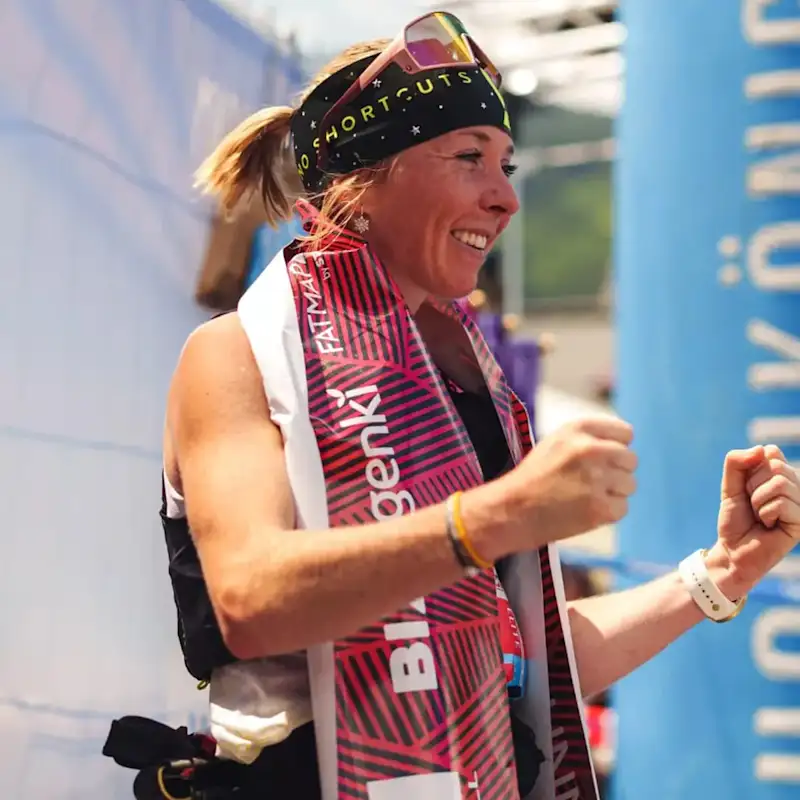
Iris Pessey
MCC by UTMB
Iris' headline numbers
Iris' strategy
Fueling
Carbohydrate is the main fuel you burn when racing. Failing to fuel properly is a leading cause of underperformance in longer races.
Iris began the MCC more slowly than her previous race three days earlier, in which she set off too fast and suffered later in the race as a result. She paced the race better in Chamonix, and gradually made her way through the field to take victory. She arrived at the start line with fully topped up glycogen stores, following a decent weekend of recovery and carb-loading. She consumed around a quarter of a PF 90 Gel pre-race as a final dose of carbs before the gun went off. Iris felt her energy levels were consistent until the final hour of the race, when they really dropped off. This may be because of her slightly lower than recommended carb intake mid-race, taking just ~58g per hour. Adding a couple more PF 30 Gels to her running belt would help her hit the ~75g/h target for a race of this intensity and duration and help her keep pushing harder for longer.
Hydration
Taking on board an appropriate amount of fluid and sodium is essential to maintaining blood volume and supporting the cardiovascular effort needed to perform on race day.
Whilst the absolute amount of sodium and fluid consumed per hour is important, it’s critical to consider these in relation to each other. This is known as 'relative sodium concentration' and it’s expressed in milligrams per litre (mg/L). How much sodium you’re taking in per litre of fluid is more important than the absolute amount taken in per hour.
Sweat sodium concentration (mg/L) is largely genetically determined and remains relatively stable. Knowing how salty your sweat is enables you to replace a good proportion of your sweat losses, which can range from 200-2,000mg/L.
Whilst Iris’s losses are on the low side, getting her hydration strategy right is still crucial when it’s hot and/or humid as her higher sweat rate in these conditions can result in significant net losses over the duration of a race.
Learn moreWarm conditions on race day (~22℃ / 72℉), coupled with Iris’s moderate sweat volume and sodium losses, meant her net fluid and electrolyte losses were not insignificant over this duration of race. Ahead of her next race, she may look to pre-hydrate more appropriately and also rehydrate more effectively from her previous race by reducing the volume of plain water she drinks the evening and morning before. Instead of drinking plain water, she could implement a preloading protocol using a high-strength sodium drink. Her mid-race strategy was likely appropriate, but her dehydrated state on the start line likely contributed to her thirstiness on the finish line. Perhaps reducing the ‘saltiness’ of her drinks slightly mid-race to more closely match her sweat sodium concentration could also help with this.
Caffeine
Beyond the Three Levers of Performance (carb, sodium and fluid), caffeine is one of only a few substances that is proven to improve performance for most endurance athletes as it can help stave off mental and physical fatigue.
Iris had a double espresso around two hours before the race began, which has roughly the same caffeine content as one of our PF 30 Caffeine Gels at ~100mg. This, combined with her Caffeine Gel mid-race, meant she likely had an adequate amount of the stimulant in her system to reap the associated ergogenic benefits.
How Iris hit her numbers
Here's everything that Iris ate and drank on the day...
Iris' weapons of choice
Final thoughts
Iris' full stats
Data Confidence?
There is an adequate level of accuracy in the data collected and the numbers reported. The athlete manages to recall what they ate and drank including most specifics (brands flavours quantities plausible estimations of volumes). However there are estimations made within the data which affect the overall confidence level in the data reported.